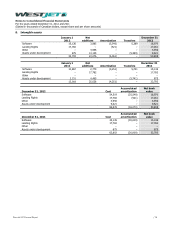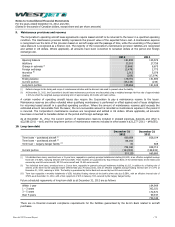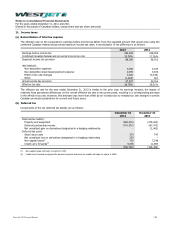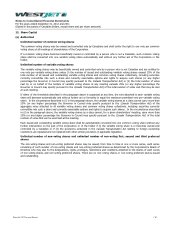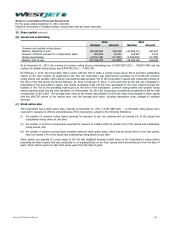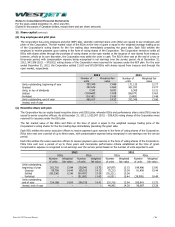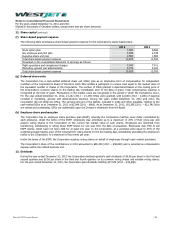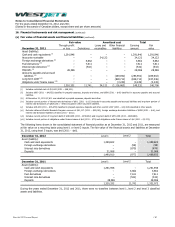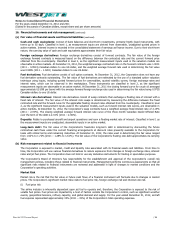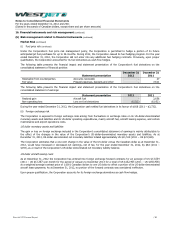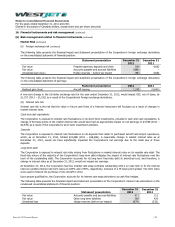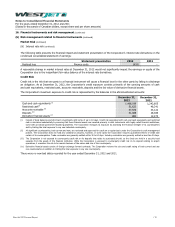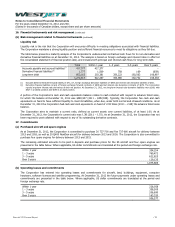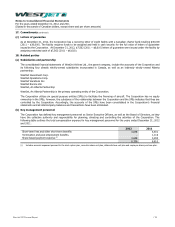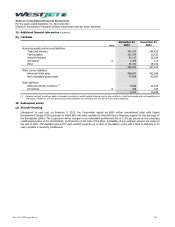Westjet 2012 Annual Report Download - page 88
Download and view the complete annual report
Please find page 88 of the 2012 Westjet annual report below. You can navigate through the pages in the report by either clicking on the pages listed below, or by using the keyword search tool below to find specific information within the annual report.
Notes to Consolidated Financial Statements
For the years ended December 31, 2012 and 2011
(Stated in thousands of Canadian dollars, except share and per share amounts)
16. Financial instruments and risk management (continued)
(a) Fair value of financial assets and financial liabilities (continued)
Cash and cash equivalents: Consist of bank balances and short-term investments, primarily highly liquid instruments, with
terms up to 92 days. Classified in level 1, as measurement inputs are derived from observable, unadjusted quoted prices in
active markets. Interest income is recorded in the consolidated statement of earnings as finance income. Due to their short-term
nature, the carrying value of cash and cash equivalents approximates their fair value.
Foreign exchange derivatives: Foreign exchange derivatives consist of forward contracts. The fair value of the foreign
exchange forward contracts is measured based on the difference between the contracted rate and the current forward price
obtained from the counterparty. Classified in level 2, as the significant measurement inputs used in the valuation models are
observable in active markets. At December 31, 2012, the weighted average contracted rate on the forward contracts was 1.0001
(2011 – 0.9914) Canadian dollars to one US dollar, and the weighted average forward rate used in determining the fair value
was 0.9995 (2011 – 1.0201) Canadian dollars to one US dollar.
Fuel derivatives: Fuel derivatives consist of call option contracts. At December 31, 2012, the Corporation does not have any
fuel derivative contracts outstanding. The fair value of fuel derivatives are estimated by the use of a standard option valuation
technique using inputs, including quoted forward prices for commodities, quoted volatility curves, foreign exchange rates and
interest rates, which can be observed in the marketplace. These instruments are classified in level 2, as the significant
measurement inputs are observable in an active market. At December 31, 2011 the closing forward curve for crude oil averaged
approximately US $99 per barrel with the average forward foreign exchange rate used in determining the fair value being 0.9755
Canadian dollars to one US dollar.
Interest rate derivatives: Interest rate derivatives consist of swap contracts that exchange a floating rate of interest with a
fixed rate of interest. The fair value of the interest rate swaps is determined by measuring the difference between the fixed
contracted rate and the forward curve for the applicable floating interest rates obtained from the counterparty. Classified in level
2, as the significant measurement inputs used in the valuation models, such as forward interest rate curves, are observable in
active markets. At December 31, 2012, the Corporation’s swap contracts have a weighted average fixed interest rate of 2.19%
(2011 – 2.19%). The closing weighted average forward interest rate curve of the three month Canadian Dealer Offered Rate
over the term of the debt is 2.01% (2011 – 2.06%).
Deposits: Relate to purchased aircraft and airport operations and earn a floating market rate of interest. Classified in level 1 as
the measurement inputs are unadjusted, observable inputs in an active market.
Long-term debt: The fair value of the Corporation’s fixed-rate long-term debt is determined by discounting the future
contractual cash flows under the current financing arrangements at discount rates presently available to the Corporation for
loans with similar terms and remaining maturities. At December 31, 2012, the rates used in determining the fair value ranged
from 1.52% to 1.72% (2011 – 1.28% to 1.61%). The fair value of the Corporation’s floating rate debt approximates its carrying
value.
(b) Risk management related to financial instruments
The Corporation is exposed to market, credit and liquidity risks associated with its financial assets and liabilities. From time to
time, the Corporation will use various financial derivatives to reduce exposures from changes in foreign exchange rates, interest
rates and jet fuel prices. The Corporation does not hold or use any derivative instruments for trading or speculative purposes.
The Corporation’s Board of Directors has responsibility for the establishment and approval of the Corporation’s overall risk
management policies, including those related to financial instruments. Management performs continuous assessments so that all
significant risks related to financial instruments are reviewed and addressed in light of changes to market conditions and the
Corporation’s operating activities.
Market Risk
Market risk is the risk that the fair value or future cash flows of a financial instrument will fluctuate due to changes in market
prices. The Corporation’s significant market risks relate to fuel price risk, foreign exchange risk and interest rate risk.
(i) Fuel price risk
The airline industry is inherently dependent upon jet fuel to operate and, therefore, the Corporation is exposed to the risk of
volatile fuel prices. Fuel prices are impacted by a host of factors outside the Corporation’s control, such as significant weather
events, geopolitical tensions, refinery capacity, and global demand and supply. For the year ended December 31, 2012, aircraft
fuel expense represented approximately 33% (2011 – 33%) of the Corporation’s total operating expenses.
WestJet 2012 Annual Report
/ 88


